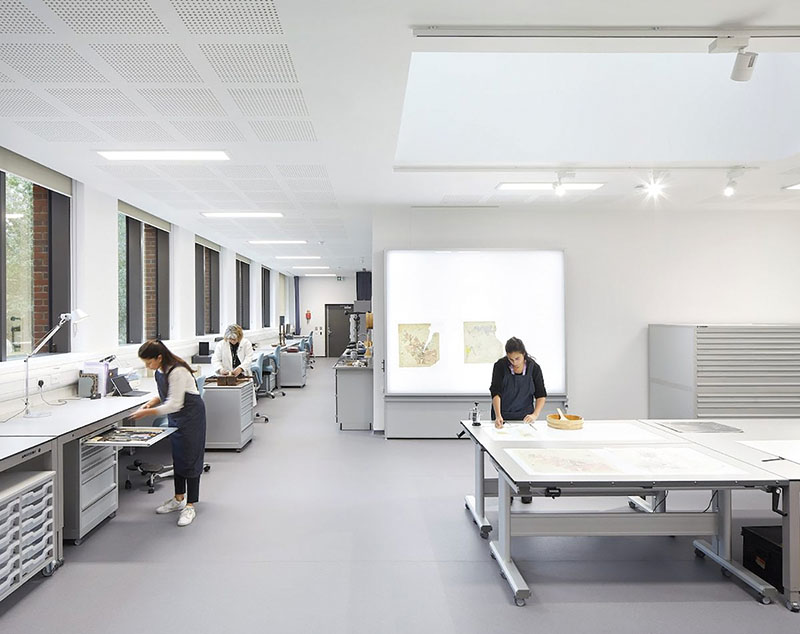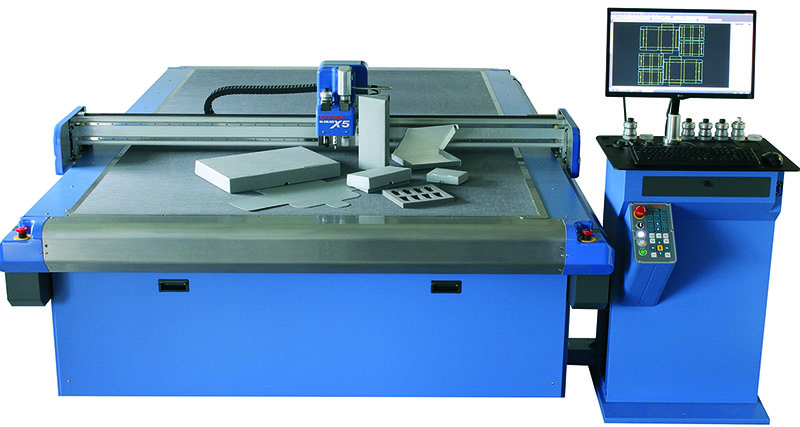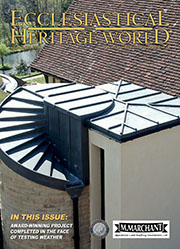Conservators are aided behind the scenes by cutting-edge paper producers
 CXD International – Conservation By Design – have been designing and furnishing conservation studios since 1992. Working in partnership with conservation professionals, they help them to obtain well-designed, high-quality furniture and equipment which fits their precise requirements. No two studios are alike, but over the years and through close involvement with conservators, they have designed and built a range of products that can be adapted to fit most needs.
CXD International – Conservation By Design – have been designing and furnishing conservation studios since 1992. Working in partnership with conservation professionals, they help them to obtain well-designed, high-quality furniture and equipment which fits their precise requirements. No two studios are alike, but over the years and through close involvement with conservators, they have designed and built a range of products that can be adapted to fit most needs.
The new conservation studios at Lambeth Palace (right), which were designed with senior conservator Lara Artemis ACR, are the latest example of CXD's contribution to the creation of an outstanding facility. Interestingly, CXD also helped furnish the first conservation studio at Lambeth Palace, set up by Bill Topping, so it gave them great pleasure to contribute to Lara’s new state of the art studio!
Click here for further information on this project.
In addition to furniture, they are a leading manufacturer and supplier of conservation products to the ecclesiastical world, providing acid-free paper, boards, archival boxes and safe transparent polyester display products as well as equipment for conservators and librarians alike. Over the years they have built up an impressive list of ecclesiastical clients, from cathedrals to chapels – all of which hold treasures and records the team at CXD take pleasure in helping them to protect and preserve. CXD are product innovators and have developed many of the products which are now relied upon by conservators in the UK and Europe. They pride themselves on the quality of their products and are the proud holders of a Royal Warrant of Appointment to Her Majesty Queen Elizabeth II.
In 1992, CXD was the first company outside the USA to supply individually custom-made acid-free boxes, using the Kasemake CXD computer-aided design box-making machine (below), to its library and conservation clients. That allowed the company to produce boxes tailor made to hold and protect a book or object. Combined with the CXD Premier Archival folding boxboard, the production of boxes for the preservation of rare books was revolutionised.
CXD decided that it would not only make boxes on that machine, but also sell the machine along with its archival boxboard to the larger institutions that until then were making tailor-made boxes by hand: a lengthy and expensive process, and the boxes did not have the refinements offered by the Kasemake CXD system.
The first customer to order a machine was the National Library of Scotland. That was followed by the Bodleian Library, The British Library and the National Library of Wales.
CXD founder and Group Product Director, Stuart Welch, takes up the story: “Soon after, we were surprised to receive an email enquiry for the Kasemake CXD from the Archivo Secreto Vaticano, The Vatican Secret Archive, who went on to buy a machine and large quantities of our Duke Parchment colour Premier Archival folding boxboard.
“They chose this colour because they have many large volumes bound with parchment. The shade of this boxboard had been made for the Duke Humphrey’s library at The Bodleian in Oxford. They wanted a board that would match the many parchment bindings in the old library. We asked the conservator Sabina Pugh to supply us with the parchment shade we had to match our boxboard to, and this is how it got the name Duke Parchment.

“Previously, we had made a sepia-coloured board, to match the leather bindings at The Bodleian. This board is also used by the National Trust for making ‘book shoes’, which are designed to support the text block and protect the covers while allowing the original book spine to be on show to the public. We consequently supplied a large quantity of this colour board to the St Catherine’s Foundation, for use by Professor Nicholas Pickwoad and his team to make bookshoes for the early printed books in the new library at the St Catherine’s Monastery in the Sinai Desert. Making board of a suitable quality for the dry conditions at the monastery was quite a challenge.”
CXD has also had the pleasure of working with Professor Pickwoad and the St Catherine’s Foundation to design and prototype earthquake-proof and fire-resistant stainless-steel boxes, which hold one volume per box. Each volume is enclosed within a cruciform style ‘phase box’ made from CXD Premier Grey-White colour boxboard. CXD equally developed the prototype racking which comprised a tray for each box. The stainless-steel boxes have beautifully engineered handles, and an engraved plate is attached to each box to identify its content. The trays and boxes were secured behind decorative, fretwork, brass doors.
The rebuilding of the library and conservation of the books was funded by donors to the St Catherine’s Foundation. The library did have the oldest complete copy of the New Testament gospels in Greek – the Codex Sinaiticus, now mostly in the British Library – and still does have the earliest copy of the gospels in Syriac, amongst other early treasures. The library at St Catherine’s Monastery is the oldest library in Christendom with an unbroken history and possessed of the second largest collection of medieval Greek manuscripts after the Vatican.
St Catherine’s Monastery is said to have been given protection by the prophet Mohamed as it had taken him in during his pre-prophet days as he travelled across the Sinai. The monastery has a large document called the Achtnames which is supposed to be a 16th-century copy of the original, signed with the prophet’s hand in gold, the original itself being said to be in Istanbul. The monks from St Catherine’s used to travel with small copies of the text tucked into their sleeves, written in both Arabic and Turkish, in case they were waylaid by angry Moslems as they travelled.
In 1992 CXD introduced vacuum packing for library material and in 1997 Stuart Welch invented the ‘squelch drying’ method for drying wet books. Following support from the British Council and HRH the Prince of Wales, the method was used to great effect – and was thus consequently noted as the best method of drying and recovering rare books – in the aftermath of the Prague flood of 2002. It was used again in 2011 following the Institute of Egypt Library fire in Cairo – supported by the Thesaurus Islamicus Foundation.
In 1985 Stuart Welch had set up a company in Paris to service the French market with acid-free paper, boards and boxes which he developed in the UK and had earned a high reputation during a time when nothing of similar quality was made in Europe. He also introduced traditional high-quality paper from Japan, as well as a range of materials, equipment and furniture, which CXD now supply through its wholly owned subsidiary CXD France. Post Brexit the company provides an outlet for British-made products in the European market.
Stuart Welch commented: “We are committed to manufacturing products in the UK and have recently purchased a range of paper conversion machinery, in order to increase our productivity while offering new possibilities to our customers in the market for conservation products.
“At CXD we are passionate to support conservators, librarians, archivists and family historians, at all levels, in preserving items of national, international and personal significance.”
• For further information visit www.cxdinternational.com













